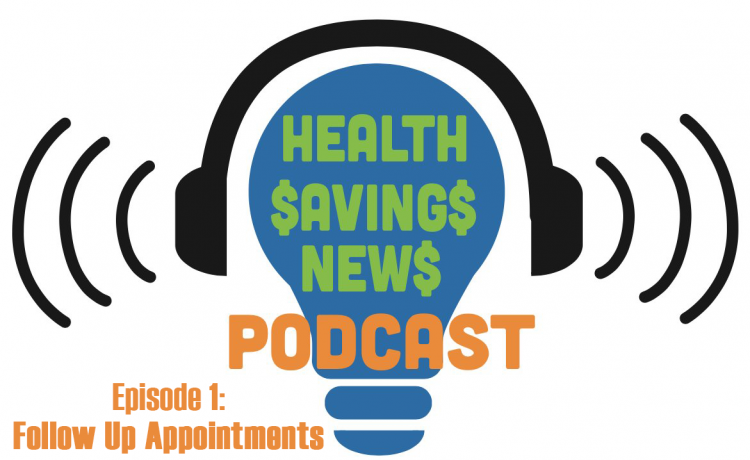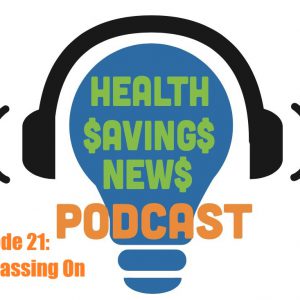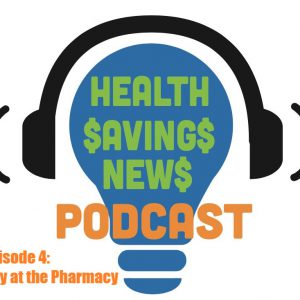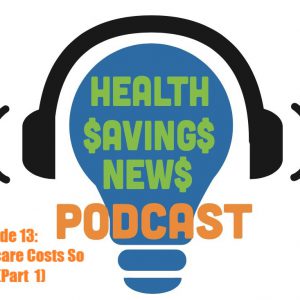NeedyMeds is excited to launch our new podcast, Health Savings News! In the interest of making the podcast more accessible, we will post transcripts every two weeks as episodes release.
Evan (00:10):
Hello, and welcome to Health Savings News, the new podcast about healthcare costs in America and how to save money on the often expensive care all kinds of people need. I’m your host, Evan O’Connor, joined by retired doctors, Rich Sagall and Mike Woods. Do you guys want to introduce yourselves?
Rich (00:27):
This is Rich. My background is family medicine and occupational medicine, and I am also the co-founder and president of NeedyMeds.
Mike (00:39):
This is Mike Woods. I’m a pediatrician who’s been retired from practice for about 10 years. I’ve spent the time since then in multiple roles. One is a medical editor of patient education literature and a writer of topics for pediatric providers, helping them to keep up to date on the latest medical care. As the special projects coordinator here at NeedyMeds, Health Savings News is one of my special projects. I started researching it and building up information over a couple years ago as a way to help people understand why our healthcare is so expensive and how they can reduce cost for it. So I’m anxious to start presenting some of this information for you. And as having pointed out, this is our first podcast to start doing that for you.
Evan (01:38):
Rich and Mike have over 50 years combined experience working in healthcare. As they’ve said before, we all work together at NeedyMeds, a national nonprofit information resource that connects people in need to programs that can offer them help to afford prescribed medications and other healthcare costs. I’m the content specialist at NeedyMeds where I’ve researched, produced, and written and video content for the past nine years. Mike is special projects coordinator, and Rich is the founder and president. Rich, if you wanna talk a bit more about NeedyMeds that would be great for our audience.
Rich (02:11):
Sure. As you mentioned, there are many who use NeedyMeds as an information source. We have data on about 35,000 different programs to help people who can’t afford medications and healthcare costs that cover all different types of programs. This includes programs that cover medication costs, free low cost sliding scale clinics programs that help based upon diagnosis, camp scholarships, and retreats, state programs, $4, generic programs, and many other types of programs. They’re all listed on our website, which is www.needymeds.org. The website gets about 10 to 15,000 visitors most work days. We also have a free helpline, which gets 4,000 to 6,000 calls a month.
Evan (03:00):
We’ll put the contact info for the helpline at the end of the show. But yeah, we all work together at NeedyMeds. We care a lot about healthcare costs and I know you’ve said before in other venues, Rich, that ideally NeedyMeds wouldn’t need to exist. We could all just go home. But unfortunately there is a need in the United States. So each episode of Health Savings News, we will have tips for saving on your healthcare costs, a topic for discussion, and relevant news that affect and reflect the health expensive landscape of healthcare in America.
Mike (03:35):
I think the important thing is that Rich and I have a long clinical background. And we think that makes us unique to help patients strike a good balance between saving money and still having the best possible healthcare. Even though both of us have retired from practice, we both still have the best interests of patients in mind with whatever we do.
Evan (04:09):
Absolutely. We’ll probably talk about it in future episodes, but the cost of care and the quality of care aren’t always relative in the U.S. Our first topic of conversation is follow-up appointments and unnecessary costs that can be associated with them. Waste accounts for about 25% of U.S. healthcare spending. The annual cost of waste from overtreatment or low value care is estimated from 75.7 billion to over 100 billion dollars a year. Out-of-pocket costs often include gas and transportation, meals, loss of pay for missing work, copayments deductibles, lodging if the appointment is far from home, and childcare.
Mike (04:58):
I’d like to start by pointing out that we’re talking specifically about follow-up appointments where you physically have to go to the office. We’re not really talking about phone calls or other ways that the doctor can contact you. We’re talking about having to leave your house, get in your car and go to the doctor’s office. We feel that that’s not needed as often as it’s really done. And that’s what we would like to focus on during this discussion.
Rich (05:39):
What got me interested in this was one of my employees was talking to me about a follow up visit she had for surgery on her foot. She was complaining she had to take half a day off work, drive about 40 miles, and miss time at work. And when she got there, the doctor looked at her foot, said “any problems?” She said, “no.” And he said, “fine, you’re all done.” And she felt that that was a wasted visit.
Mike (06:05):
Yeah, I’d agree with that. I would like to give some background about why physicians want to do follow-up appointments. And unfortunately I think Rich and I would both agree that it’s really just training and habit. We learn in medical school that it’s important to do follow-ups. A lot of time, it’s not really stressed why, it’s just business as usual asking a patient to come back. Over time a new way of approaching medicine has evolved, which is to look for evidence for what doctors do. And we need to look at this evidence and try to figure out when you actually need to come into the office physically to be seen. And the answer can’t be, “I’ve always done it this way,” because a lot of us were trained years and years ago. And to think that what we learned 30 years ago is still relevant or valid now is the height of hubris.
Rich (07:28):
We need to look at what the physician expects from the visit, what the patient expects from the visit, make sure they coincide and what can be done without having to have a visit. With the rise of telehealth, the scope of when someone needs to be seen in the office has changed. The only valid reason to see somebody is because you want to do something that cannot be done without seeing the patient or without examining them.
Mike (07:56):
Yeah, I’ve listed some things that you really need to think about before either agreeing to an appointment or if you are a provider actually asking for one. The first and foremost is what am I going to do with the visit? Are there going to be any changes made in my medical care? Is there any testing that I might need that might change my medical care? Will there be any physical findings that need to be seen, heard, or touched that can’t be done with a camera or microphone or because the technology may not be up to the resolution needed to look at some of these things. For instance, you can’t see ear fluid over a camera. You can’t really hear subtle wheezes, which would be important after an asthmatic attack or changes in murmurs. You can’t examine a joint for range of motion over the phone. As a physician trying to learn about rashes by looking at pictures, I found it was not very valuable because rashes are three dimensional in many cases. So in a lot of cases to actually truly evaluate a rash, you have to touch it to see if it has bumps or swelling or heat or other features. A lot of times when I did follow ups, I did it to assess compliance. Your patient may tell you one thing over the phone, but looking at them in person you can tell that they’re not really doing what you’re saying. I found that very common with asthmatics who assured me they were taking their medicine, but when they came into the office, they looked and sounded terrible. For the most part, people with severe illnesses probably need to be seen. You can feel better, but you can still be in trouble. And it will take examination, sometimes vital signs, to actually do that. And finally, there are certain diseases where subtle findings may not be evident except in person, such as people with cancer, diabetes, heart failure, or other significant chronic diseases.
Rich (10:10):
I think it’s important for the patient to ask the physician or healthcare provider, what are you going to be looking for at this visit? What sorts of things are you gonna be evaluating when I come in? So if you had surgery, they may talk about looking at the incision and how the healing is, whether there are any signs of infection. Some of the things you can do at home, you can do yourself. And that’s what we wanna discuss because that’s where extra care and extra costs come into play.
Mike (10:41):
Yeah. For instance, if you need a dressing change, it depends on how complicated the dressing is. You may need to go into the office and have it done, or you may actually have it done by a visiting nurse who could come to the house for much less cost, or in many cases, you can even do it yourself. It really comes down to the situation. That’s another thing that I think Rich and I need to stress is that it’s not black or white with follow-ups. Everything is situational. And if your doctor’s not looking at your specific situation and including how mobile you are, or if you have a car available, whatever, they’re not doing their job
Rich (11:23):
Well, that’s true. And I think that the follow-up visits sometimes have a bad reputation because people come in, they’re very short, and they wonder whether the doctor ordered the visit just to be able to charge for another visit, whether it was really necessary.
Mike (11:43):
Yeah. Although for the most part for some surgical procedures, the follow up visit is part of the original cost. So you’re pretty sure that that’s not the reason, but, you know, having said that I have had many surgical follow up visits that were totally unnecessary that I went to anyway, just because I’m a doctor and I have to, you know.
Rich (12:07):
Because you’re a doctor and you shouldn’t treat yourself.
Mike (12:10):
That’s right. And I want to support my fellow physicians and what they want me to do. Yes.
Rich (12:15):
But one of the questions you should always keep in mind is to ask the doctor how whatever he or she wants to do is gonna change the treatment. Cuz if they say, well, it’s not going to, then is there really a need to come in? I know my wife had a fracture and every visit, the orthopedist wanted to get an x-ray and yet it never would’ve changed the treatment.
Evan (12:39):
As you guys have said, the reasons for necessary follow up appointments are varied. As individual as your patients, often. Patients may be looking for reassurances, insurance companies may require prior authorizations for referrals, or doctors may have legitimate concerns from reported symptoms that could easily develop into something serious or just as easily be innocuous. As Mike said, there are obviously some follow up visits that are essential to maintain the health of patients, especially for cancer treatments, with certain conditions, and under other specific circumstances.
Mike (13:13):
Yeah. All is not gloomy. There’s actually a resource that I find very useful that patients will as well. And it’s a website called ChoosingWisely. It’s based out of Canada and what it does is look at evidence for things that have been done in medical care for decades and decades. And tells us which ones really are valuable and which ones have not been over the years. Medicine is evolving through evidence and the same thing is true of follow up. So this is a good sign. When you go on the website, there’s a patient version that starts with five important questions to ask the doctor. And the first one on the list is what Rich says: why is this necessary? When you look at the physician version of this, some of the things that they talk about are really turning heads. And those of us who are into evidence based medicine, find some of the things that are still in use are very scary. I have a couple of pet peeve ones. One of them is providers who do a rapid strep test on anyone with a sore throat, whether they look sick or not. When you do that, it’s actually a worthless endeavor. If your patient’s not sick, you’re about a hundred times more likely to pick up a harmless carrier state and put your patient on antibiotics unnecessarily. I’ve seen providers who continue to use routine urine exams for otherwise healthy patients that usually only involve additional testing and anxiety on the patient’s part until the urine comes back negative. And the final one that really bothers me is, is ankle x-rays on sprained ankles. The recommendation is there are certain physical exam findings, that are very uncommon with sprained ankles, that will tell a doctor that they really needed an x-ray. However, when you talk to emergency room physicians, they say, “oh, I don’t have time for that. I just get the x-ray before I even see the patient. And you know, when I see the patient and I have the x-ray there. I don’t have time to see the patient, get the x-ray and then see the patient again.” This bothers me a lot, and I just, it’s hard for me to understand physicians who just don’t evolve with medicine and just continue to do things just because they’ve always done that.
Rich (16:10):
We’ll be talking more about that in future podcasts, including things like the regular physical exam, routine lab work, x-rays, et cetera. We’ll hold out, hold off on that for other other podcasts.
Evan (16:24):
Yeah. There’s a lot of subjects for discussion that we’ll definitely touch on in future episodes. I have one more thing I’m gonna say on this topic. Studies from the American Medical Associations show that 70% of the roughly billion physician visits Americans access each year are unnecessary and could be mitigated by a phone call, email, or text. And as you’ve both said, telemedicine appointments can be an effective alternative to office based visits that is both acceptable and more affordable for patients.
[segment break]
Evan (16:58):
The last segment of each episode, we’re going to suggest some of the culture, art, entertainment, and social causes we’ve been engaged with to each other and our listeners. I’ve been listening to America Dissected with Dr. Abdul El-Sayed, a podcast on the Crooked Media Network. The host is a former health commissioner in Detroit, and he speaks really authoritatively and it’s very informative. Really good recent episodes (at the time of recording) have been on teeth with Mary Otto, who is a journalist and author of the book Teeth: The Story of Beauty, Equality, and Struggle for Oral Health in America. There was a really great listener mail Q-and-A episode with Tre’vell Anderson, who’s another award winning journalist. And the most recent episode I have queued up — I haven’t listened to the whole thing — is about the innovation gap between the health challenges of marginalized people and how they are not usually catered to with effective treatments tailored to their unique health challenges: being low income, Black, LGBT+, women, all sorts of things. They are very interesting podcasts that I would suggest to you specifically Rich, but anybody who would be interested in that kind of stuff.
Rich (18:13):
I will suggest another podcast called Public Health On Call. This comes from Johns Hopkins School of Public Health, and they put out many podcasts talking about public health issues. Obviously COVID has been an important one, but they’ve been talking about other issues all also. They’re short, about 15 minutes, not full of jargon and have very good experts. I highly recommend it. If you wanna know what’s going on in public health and wanna stay apprised of the latest in COVID diagnosis and treatment.
Mike (18:46):
Rather than follow podcasts, I actually follow issues. The primary issue that I’m following now is COVID and I’m writing articles for one of our sister websites called BeMedWise and trying to inform users of the truth behind what’s going on with COVID. There’s a lot of misinformation out there. There’s a lot of misunderstanding of the science. There’s a lot of political overlay and for some reason, an awful lot of anger associated with the issue. So I’m hoping that the topics I am creating for BeMedWise will answer all of these questions and give people a good and accurate overview of the COVID pandemic as it continues to evolve.
Evan (19:40):
Thank you all so much for joining us for this first episode of Health Savings News. Please subscribe, rate, and review us on iTunes or wherever you’re listening to the show. It really does help. Health Savings News is a bi-monthly podcast. Catch our next episode in two weeks. You can follow @NeedyMeds on Twitter, Facebook, Instagram, LinkedIn, YouTube, and you can follow @HealthSavingPod — no S at the end of savings — on Twitter for updates specific to this podcast. Send questions, comments, and topic suggestions to podcast@needymeds.org. Our music is composed by Samuel Rulon Miller. His music can be found at musicisadirtyword.bandcamp.com. All of our sources we used in our research can be found in this episode’s podcast description, our website, or your podcast app of choice. Health Savings News is not intended to substitute for professional medical, financial or legal advice. Always seek the advice of a qualified healthcare professional or appropriate professional with any questions. Views expressed on Health Savings News are solely those of the individual expressing them. Any views expressed do not necessarily represent the views of Health Savings News, other contributors, NeedyMeds organization or staff.
Sources:
https://www.ncbi.nlm.nih.gov/pmc/articles/PMC5587107/
https://www.medicaleconomics.com/view/11-reasons-why-there-are-unnecessary-medical-visits
https://www.liebertpub.com/doi/abs/10.1089/tmj.2020.0147?journalCode=tmj





